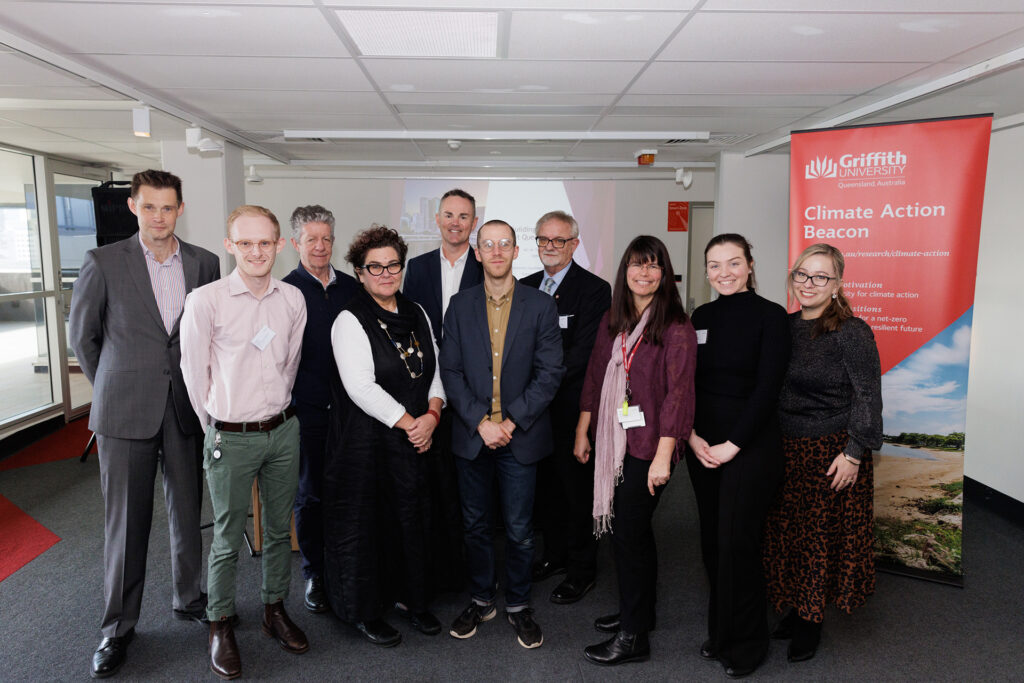With temperatures rising across the globe, the need to adapt our communities to a warmer world is both urgent and essential. Recognising this, the Climate Action Beacon’s Queensland Heat Health Community of Practice (QHHCoP) recently hosted esteemed speakers to discuss how we can build heat resilience across Queensland.
The ‘Building a Heat Resilient Queensland’ event brought together a range of experts, practitioners and stakeholders across the state to illuminate barriers preventing heat resilience and envisioning pathways to get there by 2033.
From insightful presentations to engaging panel discussions, attendees were immersed in a wealth of knowledge and ideas aimed at mitigating the adverse effects of heatwaves from the perspectives of members working in architecture, disaster management, industry development and tenant advocacy.
To set the scene, Climate Action Beacon director Professor Brendan Mackey presented the current evidence from the Intergovernmental Panel on Climate Change (IPCC) reports, demonstrating a global temperature increase of 1.1C since the industrial revolution. Without radical reduction in emissions, this figure is expected to keep rising, leading to exacerbated climate extremes.
From 1900 to 2015, Australia has already experienced 4,555 deaths from extreme heat. Projections for the future climate predict that these heatwaves will become longer, more frequent and more intense — echoing the need to build heat resilience.
As the acting Inspector-General of Emergency Management Ian Thompson presented, the need for heat resilience as part of disaster management planning is critical. Heatwaves are considered disasters, therefore the importance of shared responsibility across communities as well as local and state governments, is imperative. Increased heat will have cascading and compounding effects making prevention, preparedness, response and recovery (PPRR) essential to enhance community resilience.
There are several ways to reduce heat gain in buildings and the built environment, as explained by Moreton Bay Regional Council’s Principal Architect, Liza Neil. Adding greenery, water features, airflow and choosing the right materials and colours, are all important when considering heat adaption. However, there is also a need to design for energy sufficiency in the event of a power outage. Employing these strategies will require productive collaborations across disciplines, emphasising the importance of the QHHCoP.

Talking on behalf of the development industry, Senior Environment and Community Development Manager Mark Stephens demonstrated how Stockland is actively creating heat resilient communities using Aura as a case study. Located on the Sunshine Coast, Aura has been awarded 6-star Green Star Communities rating by the Green Building Council Australia due to the development’s ‘cool roof’ policy. By mandating a white roof policy, Aura is up to 2C cooler than its neighbouring community, meaning a simple design feature has been successful in not only reducing temperatures but also helping residents save money on cooling.
Executive Director for Better Renting Joel Dignam spoke about the importance of heat resilience for renters. Rising living costs has seen an increase in older renters, with many living in substandard housing and apartments without adequate insulation or affordable cooling options. Indeed, results from their recent report, ‘Sweaty and Stressed: Renting in an Australian Summer’ found that renters were exposed to excessive heat 45% of the time during 2022-23’s summer, significantly impacting their physical and mental health. A heat resilient Queensland needs to include minimum standards for rental properties, keeping residents safe and cool, affordably.
The ‘Building a Heat Resilient Queensland’ event served as a reminder that by working together, we can create a future where our communities are better equipped to withstand the challenges of a warming climate.
The QHHCoP is a group of approximately 200 professionals across government, research, health, planning and non-profit organisations, passionate about increasing awareness, investment and uptake of heat adaptation policy across Queensland. Interested in joining? Fill out the QHHCoP Interest Form or contact our research assistant, Ella Jackman at [email protected].
For access to past event recordings, heat health resources and other information, visit our website at www.qhhcop.org.
View the ‘Building a Heat Resilient Queensland’ event recording on YouTube.
